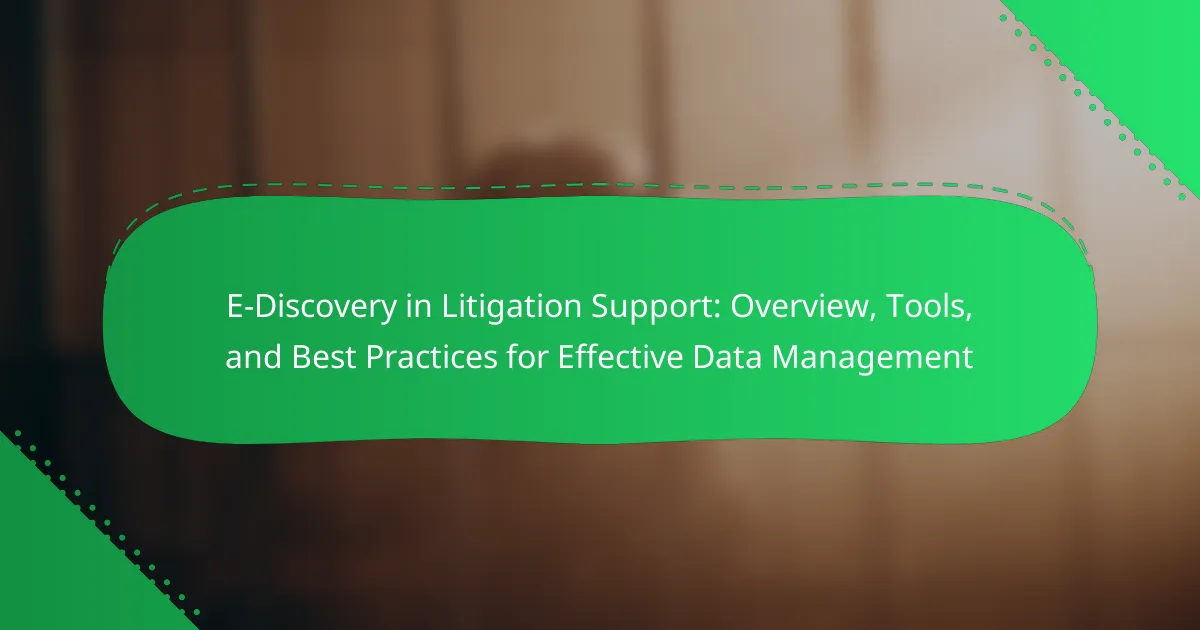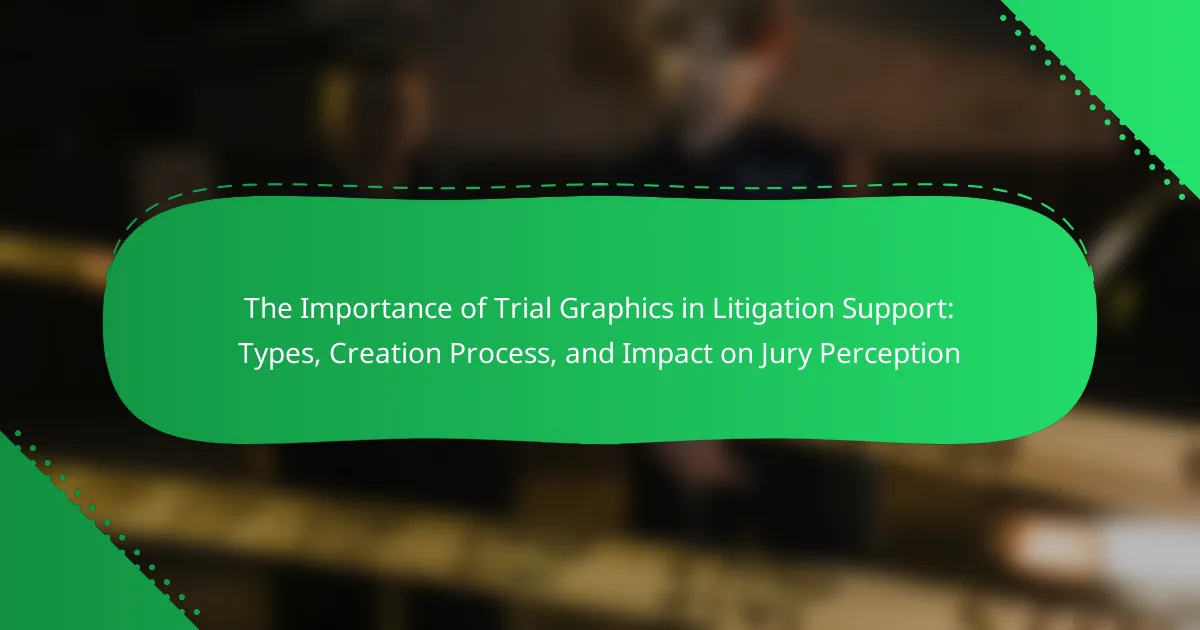E-Discovery in litigation support is the systematic process of identifying, collecting, and reviewing electronic data relevant to legal cases. This process encompasses the management of various digital information types, including emails, documents, and databases, while adhering to legal standards outlined by the Federal Rules of Civil Procedure in the United States. The article provides an overview of essential E-Discovery tools, such as Relativity and Logikcull, which facilitate efficient data retrieval and analysis. It also outlines best practices for effective data management, including establishing data retention policies, utilizing automated tools, and ensuring data security through encryption and access controls. Regular training and periodic audits are emphasized as critical components for maintaining compliance and enhancing the overall efficacy of E-Discovery processes.
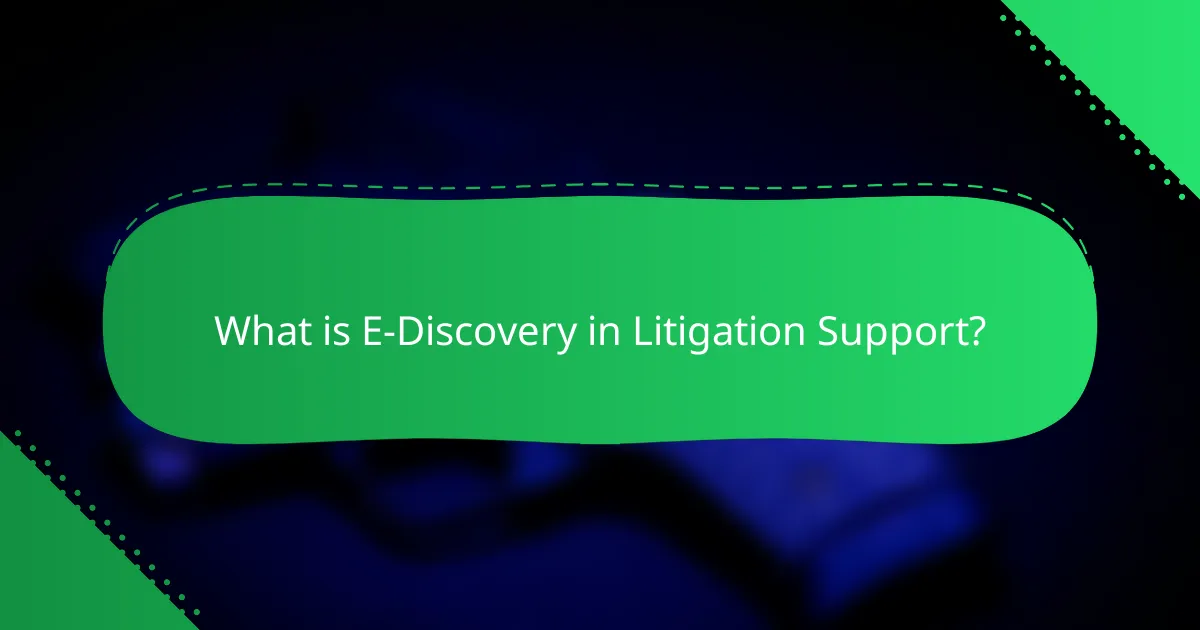
What is E-Discovery in Litigation Support?
E-Discovery in litigation support refers to the process of identifying, collecting, and reviewing electronic data for legal cases. It involves the management of digital information, such as emails, documents, and databases. E-Discovery is crucial for ensuring relevant evidence is available for court proceedings. Organizations must adhere to legal standards during this process. The Federal Rules of Civil Procedure govern E-Discovery practices in the United States. Effective E-Discovery can significantly impact the outcome of litigation. Proper tools and methodologies enhance the efficiency of data management in legal contexts.
How does E-Discovery play a role in the litigation process?
E-Discovery is a critical component of the litigation process. It involves the identification, collection, and analysis of electronically stored information (ESI). E-Discovery helps legal teams gather relevant evidence to support their cases. This process can include emails, documents, social media content, and other digital data. Effective E-Discovery can significantly impact the outcome of litigation. According to the Federal Rules of Civil Procedure, parties must disclose relevant ESI during discovery. Failure to comply can result in sanctions or adverse judgments. Thus, E-Discovery is essential for ensuring a fair trial and informed decision-making.
What are the key stages of E-Discovery?
The key stages of E-Discovery are information governance, identification, preservation, collection, processing, review, analysis, and production. Information governance involves establishing policies for data management. Identification is the process of locating relevant data sources. Preservation ensures that data is protected from alteration or deletion. Collection refers to gathering the identified data for review. Processing involves converting the data into a usable format. Review is the examination of data for relevance and privilege. Analysis provides insights into the data’s context and implications. Production is the final stage where relevant information is delivered to the requesting party. These stages are essential to ensure compliance and efficiency in legal proceedings.
How does E-Discovery differ from traditional discovery methods?
E-Discovery differs from traditional discovery methods primarily in its focus on electronic data. Traditional discovery involves physical documents and tangible evidence. E-Discovery encompasses digital files, emails, and cloud storage. This shift reflects the growing reliance on technology in legal processes. E-Discovery often requires specialized software for data collection and analysis. Traditional methods may not address the complexities of vast digital information. As of 2021, over 90% of data generated is electronic, underscoring the importance of E-Discovery. These differences impact efficiency, cost, and the scope of evidence retrieval in litigation.
What are the fundamental components of E-Discovery?
The fundamental components of E-Discovery include identification, preservation, collection, processing, review, analysis, and production of electronically stored information (ESI). Identification involves locating relevant data sources. Preservation ensures that data is not altered or destroyed. Collection refers to gathering data from identified sources. Processing prepares data for review, often involving filtering and deduplication. Review is the examination of data for relevance and privilege. Analysis assesses the context and patterns within the data. Finally, production involves delivering the relevant data to the requesting party in a usable format. Each component plays a critical role in managing E-Discovery effectively during litigation.
What types of data are commonly involved in E-Discovery?
E-Discovery commonly involves various types of data. These include emails, documents, and spreadsheets. Social media content is also frequently relevant. Additionally, audio and video files may be included. Metadata associated with these files is crucial for context. Database records can be significant in certain cases. Instant messages and text messages are often collected as well. Overall, E-Discovery encompasses a wide range of digital communications and files.
How is data collected and processed in E-Discovery?
Data in E-Discovery is collected through various methods, including data mapping, interviews, and automated tools. Legal teams identify relevant data sources, such as emails, documents, and databases. They then employ software to extract this data systematically. The collected data undergoes processing, which includes filtering, de-duplication, and indexing. This ensures that only pertinent information is retained for review. Advanced analytics may also be applied to categorize data effectively. The entire process is governed by legal standards to maintain integrity and confidentiality. Effective data collection and processing are crucial for compliance and successful litigation outcomes.
Why is E-Discovery important for legal professionals?
E-Discovery is important for legal professionals because it streamlines the process of identifying and managing electronic evidence. This practice enables lawyers to gather relevant data efficiently from various digital sources. Legal professionals rely on E-Discovery to ensure compliance with legal standards and regulations. It helps in the organization of large volumes of information, making it easier to analyze and present in court. According to the Federal Rules of Civil Procedure, E-Discovery is a crucial part of the litigation process. Effective E-Discovery can significantly reduce costs and time associated with traditional discovery methods. Additionally, it enhances the accuracy of evidence retrieval, which is vital for case outcomes. Overall, E-Discovery is essential for maintaining the integrity and efficiency of the legal process.
What risks are associated with inadequate E-Discovery practices?
Inadequate E-Discovery practices can lead to significant legal and financial risks. These risks include potential sanctions from courts for failing to produce relevant evidence. Organizations may face increased litigation costs due to extended discovery processes. Poor data management can result in loss of important information, leading to unfavorable case outcomes. Inadequate practices may also damage an organization’s reputation and trustworthiness. Compliance failures can lead to regulatory penalties, affecting business operations. Additionally, ineffective E-Discovery can hinder the ability to respond to legal inquiries promptly. Overall, these risks underscore the importance of robust E-Discovery strategies in litigation support.
How does E-Discovery impact case outcomes?
E-Discovery significantly impacts case outcomes by influencing the availability and quality of evidence. It allows parties to collect, review, and analyze electronic data relevant to the case. Effective e-discovery can uncover critical information that supports a party’s claims or defenses. Conversely, poor e-discovery practices may result in lost evidence or missed opportunities. Studies show that 70% of legal professionals believe e-discovery affects case strategy. Moreover, timely and thorough e-discovery can lead to favorable settlements, as parties may be more willing to negotiate when they have a clear understanding of the evidence. Overall, e-discovery shapes the litigation landscape by directly affecting the strength of legal arguments.
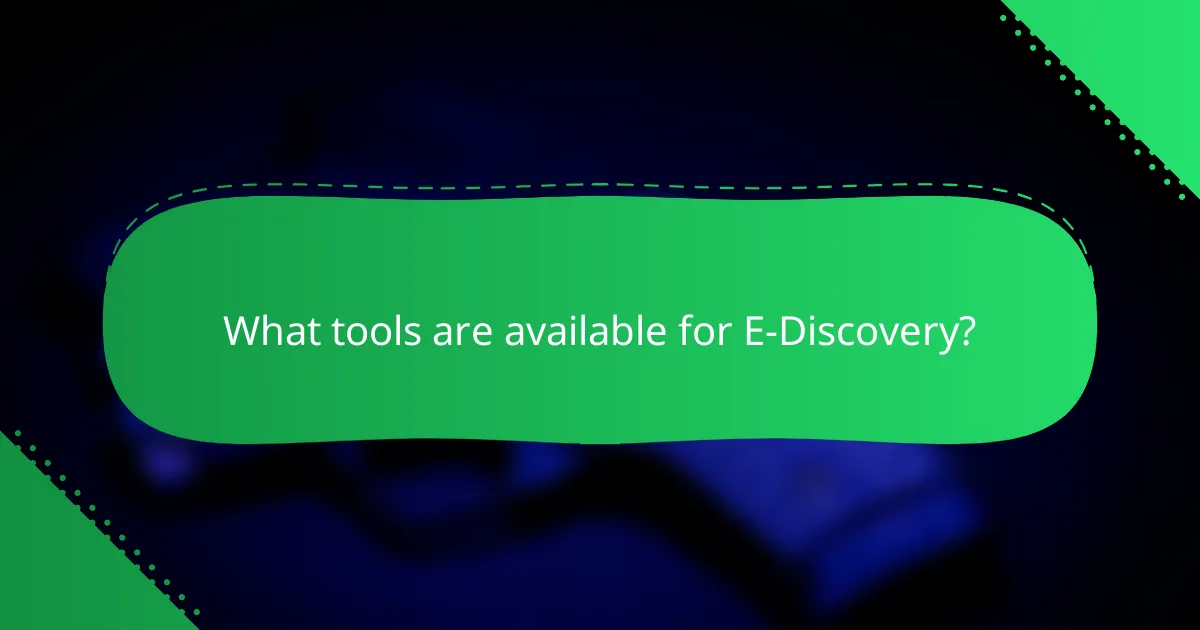
What tools are available for E-Discovery?
E-Discovery tools include software and platforms designed for electronic data retrieval and analysis. Common tools are Relativity, Logikcull, and Everlaw. These tools assist in managing large volumes of data. They provide features like document review, data processing, and analytics. Many tools support various file types and formats. Some tools offer cloud-based solutions for accessibility. Others include advanced search functionalities for efficient data retrieval. Security features are also crucial in these tools to protect sensitive information.
What are the leading E-Discovery software solutions?
The leading E-Discovery software solutions include Relativity, Logikcull, and Everlaw. Relativity is widely recognized for its comprehensive features and scalability. It supports large-scale data processing and analysis. Logikcull is known for its user-friendly interface and affordability. It simplifies the document review process for legal teams. Everlaw offers robust collaboration tools and advanced analytics. Its platform enhances team productivity during litigation. According to a 2022 report by Gartner, these solutions are among the top-rated in terms of user satisfaction and functionality.
How do these tools facilitate data management?
These tools facilitate data management by automating the process of data collection, organization, and analysis. They streamline the retrieval of relevant information from large datasets. This reduces the time and effort required for manual data handling. Tools often incorporate advanced search capabilities, allowing users to quickly locate specific documents or data points. They also enable secure data storage and sharing, ensuring compliance with legal standards. Additionally, these tools often provide analytics features that help in understanding data patterns and trends. This enhances decision-making during litigation processes. Overall, they improve efficiency and accuracy in managing data relevant to legal cases.
What features should be considered when selecting E-Discovery tools?
When selecting E-Discovery tools, consider the following features: scalability, user interface, and data processing capabilities. Scalability ensures the tool can handle large volumes of data efficiently. A user-friendly interface allows for quicker adoption and reduces training time. Robust data processing capabilities include support for various file types and advanced search functionalities. Additionally, integration with existing systems is crucial for seamless workflows. Security features, such as encryption and access controls, protect sensitive information. Lastly, customer support and vendor reputation are important for ongoing assistance and reliability.
How do cloud-based solutions compare to on-premise E-Discovery tools?
Cloud-based solutions offer flexibility and scalability that on-premise E-Discovery tools typically lack. Cloud solutions allow access from anywhere with an internet connection, enhancing collaboration among legal teams. In contrast, on-premise tools require physical hardware and can limit access to specific locations. Cloud-based systems often have lower upfront costs since they operate on a subscription model. This model allows organizations to pay for what they use without significant initial investments. Additionally, cloud solutions can provide automatic updates and maintenance, reducing the burden on IT resources. On-premise tools may require manual updates and ongoing maintenance, increasing operational costs. Security is a concern for both, but cloud providers often invest heavily in advanced security measures. According to a report by Gartner, 70% of organizations using cloud-based E-Discovery tools reported improved efficiency in data management compared to traditional on-premise solutions.
What are the benefits of using cloud solutions for E-Discovery?
Cloud solutions for E-Discovery provide enhanced accessibility, scalability, and cost-effectiveness. These solutions allow legal teams to access data from anywhere, facilitating collaboration. Scalability ensures that organizations can adjust storage needs based on case requirements. Cost-effectiveness arises from reduced infrastructure investments and maintenance costs. Additionally, cloud solutions often include advanced security features, protecting sensitive information. They also streamline data processing and analysis, improving efficiency in legal workflows. According to a report by Gartner, cloud-based E-Discovery tools can reduce overall costs by up to 30%.
What security considerations are involved with cloud-based E-Discovery?
Cloud-based E-Discovery involves several critical security considerations. Data privacy is paramount, as sensitive information may be exposed during the E-Discovery process. Encryption is essential to protect data at rest and in transit. Compliance with regulations, such as GDPR and HIPAA, is necessary to avoid legal repercussions. Access controls must be implemented to restrict unauthorized personnel from accessing sensitive data. Regular security audits and assessments are crucial to identify vulnerabilities. Additionally, incident response plans should be established to address potential data breaches swiftly. These considerations ensure the integrity and confidentiality of data throughout the E-Discovery process.
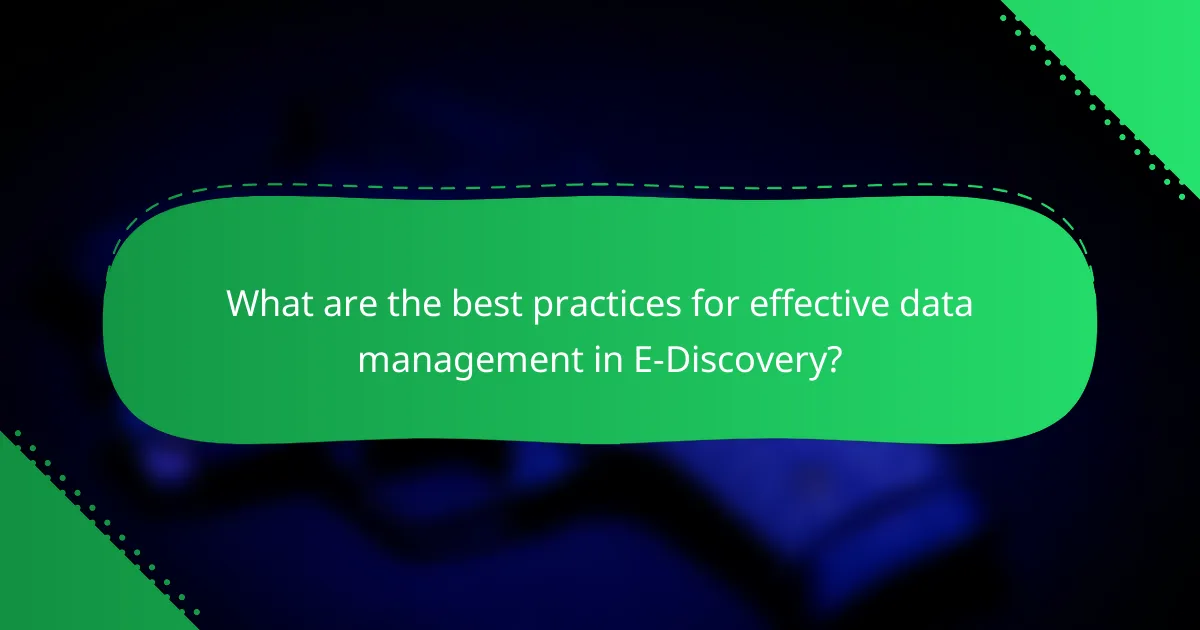
What are the best practices for effective data management in E-Discovery?
Effective data management in E-Discovery requires a structured approach. First, organizations should establish a clear data retention policy. This policy should define how long data is kept and when it should be disposed of. Second, data should be categorized and indexed for easy retrieval. This helps streamline the process during legal reviews.
Third, utilizing automated tools can enhance efficiency. These tools can assist in data collection and processing, reducing manual errors. Fourth, regular training for staff on E-Discovery best practices is essential. Knowledgeable personnel can better manage data and comply with legal requirements.
Fifth, maintaining data security is crucial. Implementing encryption and access controls protects sensitive information. Lastly, conducting periodic audits ensures compliance with policies and regulations. These audits help identify gaps in data management practices, allowing for timely corrections.
How can organizations ensure compliance during E-Discovery?
Organizations can ensure compliance during E-Discovery by implementing comprehensive policies and procedures. Establishing a clear E-Discovery protocol is essential. This protocol should outline roles and responsibilities for all stakeholders involved. Regular training sessions can help staff understand compliance requirements. Utilizing advanced E-Discovery tools can streamline data collection and review processes. Organizations should also conduct regular audits to assess adherence to compliance standards. Documenting all E-Discovery processes is crucial for accountability. By maintaining open communication with legal counsel, organizations can navigate compliance challenges effectively. These steps help mitigate risks associated with non-compliance in E-Discovery.
What policies should be established for data retention and privacy?
Data retention and privacy policies should include clear guidelines on data collection, storage, and deletion. Organizations must define the duration for which data will be retained based on legal and regulatory requirements. Regular audits should be conducted to ensure compliance with these retention schedules. Access controls must be established to limit data access to authorized personnel only. Encryption should be implemented to protect sensitive data during storage and transmission. Additionally, organizations should provide training on data privacy practices to all employees. Regular updates to the policies are necessary to adapt to changes in legislation and technology. Compliance with regulations such as GDPR and HIPAA is essential for maintaining data privacy.
How can training improve E-Discovery practices?
Training can significantly enhance E-Discovery practices by equipping professionals with essential skills. It improves understanding of legal requirements and compliance standards. Trained staff can efficiently manage data collection and processing. They are better at identifying relevant documents and reducing review time. Training also fosters familiarity with E-Discovery tools and technologies. This leads to improved accuracy in data analysis and reporting. Enhanced skills can reduce costs associated with E-Discovery processes. Overall, training creates a more competent workforce capable of navigating complex E-Discovery challenges.
What common challenges do organizations face in E-Discovery?
Organizations face several common challenges in E-Discovery. One significant challenge is the sheer volume of data. Organizations often struggle to manage and sift through large quantities of electronic information. This data can include emails, documents, and other digital files. Another challenge is ensuring data compliance with legal standards. Organizations must adhere to regulations such as the Federal Rules of Civil Procedure. Failure to comply can lead to legal penalties. Additionally, data preservation is a critical issue. Organizations must ensure that relevant information is not deleted or altered during the E-Discovery process. Cost management is also a challenge; E-Discovery can be expensive due to technology and labor costs. Lastly, organizations often face difficulties in data security and privacy. Protecting sensitive information during the E-Discovery process is paramount to avoid breaches and maintain trust.
How can these challenges be addressed effectively?
Challenges in e-discovery can be addressed effectively through the implementation of structured processes and advanced technology. Establishing clear protocols for data collection ensures compliance with legal standards. Utilizing e-discovery tools automates data management and enhances accuracy. Training legal teams on these tools improves efficiency and reduces errors. Regular audits of e-discovery practices can identify gaps and areas for improvement. Collaboration between IT and legal departments fosters better communication and resource sharing. Investing in secure data storage solutions protects sensitive information during the e-discovery process. These strategies have been shown to streamline workflows and minimize risks in litigation support.
What role does communication play in successful E-Discovery?
Communication is critical in successful E-Discovery. It ensures that all parties understand their roles and responsibilities. Clear communication facilitates the identification of relevant data sources. It also helps in establishing timelines and expectations for data delivery. Effective communication minimizes misunderstandings that can lead to delays. Regular updates keep stakeholders informed about progress and challenges. Collaboration between legal teams and IT is essential for efficient data management. Studies show that effective communication can significantly reduce the time and costs associated with E-Discovery processes.
What tips can enhance E-Discovery efficiency?
Utilizing advanced search techniques enhances E-Discovery efficiency. Implementing Boolean search operators can refine results. Organizing data into manageable categories streamlines the review process. Automating repetitive tasks reduces manual effort and errors. Leveraging machine learning tools improves document classification accuracy. Regular training for legal teams on E-Discovery tools increases proficiency. Establishing clear protocols for data handling ensures compliance and consistency. Conducting regular audits identifies areas for improvement in the E-Discovery process.
E-Discovery in litigation support is the process of identifying, collecting, and reviewing electronic data for legal cases, governed by the Federal Rules of Civil Procedure. This article provides an overview of E-Discovery, including its key stages, differences from traditional discovery methods, and the importance of effective data management for legal professionals. It also highlights the various types of data involved, the tools available for E-Discovery, and best practices for ensuring compliance and efficiency. Additionally, the article addresses common challenges organizations face in E-Discovery and offers strategies to enhance the overall process.
